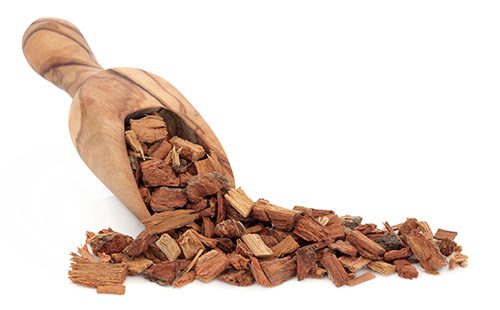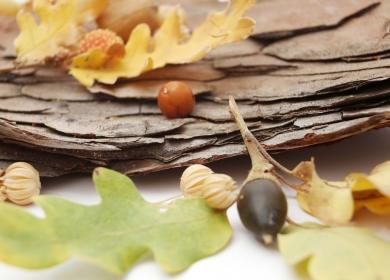The content of the article
Botanists produce over 500 species of oak. Distribution zone - regions with a temperate and warm climate of the Northern Hemisphere. The tree grows up to 40 m in height, is characterized by a well-developed root system, massive trunk, wide spreading crown.
Characteristics of raw materials
For medical purposes, use the bark of ordinary oak. It gradually thickens as the plant grows. On old trees, the thickness reaches 10 cm. The color is uniform, gray-brown, the surface is rough, cracked. On young individuals - thin, smooth, has an olive-gray color.
Procurement process
Harvesting is carried out in forestries, having received special permission. Only young trees are most suitable for harvesting, most often intended as a log house (shoots and young branches). The thickness of the bark should not exceed 6 mm. A thicker layer indicates the honorable age of the plant and the loss of useful properties by raw materials.
- Collection. In the sap flow phase, circular cuts are made on the trees intended for the log house. The distance between them should be 30 cm. Next, make a longitudinal incision, gently separate the bark from the wood with your fingers or with a knife. It will not be difficult to do this, since in the spring it is well removed.
- Training. Sort the raw materials for damaged parts - damaged by lichens, unevenly thickened.
- Drying. The raw materials are laid out in one layer on a jammed pallet. Place it in a shaded, well-ventilated place. In the process, regularly tedious. Natural drying is preferred.
Description
Raw materials intended for medicinal purposes should be crushed into pieces. It can be strips or grooves with clearly distinguishable outer and inner layers. The surface is gray-brown, olive-brown, with noticeable lentils, smooth or slightly wrinkled. The inner part is yellow-brown, fibrous, splinous. The smell is a characteristic woody, intensifies when wetted with water. The taste is highly astringent.
Chemical composition
The main chemical compounds in the composition are tannins. They should be at least 29%. React with proteins to form albuminates. This is the basis of the astringent, protective, antiexudative action of the cortex. In addition, albuminate films make internal cells invulnerable to microorganisms. Tannins can also negatively affect microbes - they provoke the destruction of the shells of bacteria, viruses, and fungal cells.
Other substances in the composition support the pharmacological properties of the raw materials. Among them:
- pectins - adsorb toxins;
- polysaccharides - show enveloping effect;
- mineral compounds - used in cellular metabolism;
- amino acids - needed for tissue regeneration.
An important role in the pharmacological activity of phytochemicals is played by organic acids - gallic and ellagic. These substances endow the raw materials with a complex antimicrobial effect - activity relative to protozoa, fungi, bacteria and viruses. Quercetin, a representative of flavonoids, strengthens the walls of blood vessels, improves blood circulation, stimulates the immune system.
Indications
In traditional medicine, bark is more often applied externally. Indications for use may include:
- wounds, burns, frostbite;
- diathesis;
- hives;
- weeping eczema;
- pressure sores;
- trophic ulcers;
- acne;
- sweating
- fungal skin diseases.
Doctors recommend a remedy for dental problems - from stomatitis, periodontal disease, to strengthen the gums and teeth, to eliminate bad breath. Among the indications and ENT diseases: tonsillitis, laryngitis, pharyngitis, sinusitis, tonsillitis. Gynecologists are often prescribed for douching in the complex treatment of cervical erosion, inflammation of the vaginal mucosa of an infectious nature, with profuse leucorrhoea.
In folk and official medicine, phyto-raw materials are used as antidiarrheal agents. Copes with diarrhea of an infectious origin, relieves the patient's condition with colitis, when diarrhea causes irritation of the intestinal mucosa. In ancient times, dysentery was treated with a herbal remedy. Raw materials are used in gastroenterology due to the complex effect on the digestive tract:
- inhibits the secretion of glands;
- prevents irritation of the mucous membranes;
- stimulates the healing of erosion;
- normalizes the absorption of fluid in the intestinal lumen;
- stops internal bleeding;
- stops vomiting;
- removes toxins.
These actions allow you to include oak bark in the treatment of poisoning, gastritis, enterocolitis, pancreatitis.
As a source of flavonoids acting as active vasoprotectors, it can be used in pathological conditions of blood vessels. The most common indication is varicose veins. In this case, the raw material relieves inflammatory processes, eliminates edema, improves the condition of the walls of blood vessels. It is also used for prone to capillary and internal bleeding. Used in folk medicine as an effective remedy for age-related decrease in potency, erectile dysfunction of vascular origin.
Flavonoids are also able to have a mild choleretic and diuretic action. In combination with the antimicrobial properties of the raw material, this allows its use in the treatment of kidney diseases of an infectious-inflammatory nature, uncomplicated urinary tract infections.
Use in cosmetology
The tool is used to obtain extracts. They are included in cosmetics, which helps to combat excessive oily and sweating skin, hair loss, acne, acne, rosacea.
Water extracts are also used to prevent problems such as fungal skin lesions, alopecia. The dermatoprotective effect of raw materials has been proven - it normalizes the protective functions of the skin, helps restore the natural lipid barrier, prevents the penetration of infections into deep structures, and stimulates the regeneration process.
Prescription Drugs
Oak bark is an affordable drug sold in pharmacies. They are released in cardboard boxes, in packings of 50, 100, 200 g.The method of brewing is described directly in the instructions, however, in traditional medicine specific recipes for various diseases are used.
Classical
Features The broth can be used for washing and lotions in case of skin damage, as well as gargling, the mouth, treat the mucous membranes.
Preparation and use
- Three tablespoons of raw materials are poured into a metal container with a glass of cold water.
- On medium heat, bring to a boil, after which the fire is reduced.
- With moderate drilling, the product is boiled for 20-25 minutes.
- Immediately after removal from the fire, the hood is filtered, adjusted with boiled water to a volume of 300 ml.
- The tool treats the affected areas of the skin up to five times a day.
For men's health
Features Unconcentrated broth is taken to normalize sexual function in men, eliminate prostatitis, urethritis, in the complex treatment of varicose veins of the inguinal veins, increase potency in vascular pathologies.
Preparation and use
- A teaspoon of raw material is poured into a container, pour a glass of boiling water.
- The vessel is installed in a water bath, languish for 10-15 minutes.
- Filter immediately after removal.
- Take inside a third of a glass three times a day before meals.
For women's health
Features In gynecology, raw materials are valued as antifungal, healing, anti-inflammatory actions. Broth is recommended to be douched with thrush, vulvovaginitis, colpitis, erosion. The tool is safe during pregnancy, but can only be used on the recommendation of a gynecologist.
Preparation and use
- Two tablespoons of raw materials are poured into a glass of boiling water.
- The mixture is placed in a water bath, boiled for 20 minutes.
- Filter immediately into a glass, bring to the original volume with boiled water.
- They are doused with broth up to four times a day.
Foot baths
Features It can be used to eliminate excessive sweating, unpleasant foot odor, in the treatment of skin fungus and the treatment of onychomycosis.
Preparation and use
- 100 g of raw material is poured into a metal container with a liter of boiling water.
- Cover the vessel with a lid, wrap it with a towel or blanket, leave for an hour or two.
- Filter, pour water into a small basin.
- Spend foot baths, heating water (it should be moderately hot).
- For the treatment of hyperhidrosis, baths are repeated daily for ten days. For the treatment of skin fungus - 20 days, and nail fungus - every other day until complete recovery.

For wound healing
Features Raw oak is combined with black poplar buds for the preparation of a healing ointment. It is used for extensive injuries of the epidermis, wet and purulent wounds, pressure sores, ulcers on the body.
Preparation and use
- A couple of tablespoons of oak bark is mixed with a spoonful of poplar buds.
- The plant mixture is ground into powder in a mortar or using a coffee grinder.
- Seven tablespoons of butter are melted and boiled over low heat.
- Hot oil is poured into the vegetable powder.
- Put the mixture overnight in a warm place.
- In the morning they again languish in a water bath for half an hour.
- When hot, the product is filtered.
- They put in the refrigerator.
- Apply under a bandage twice a day.
From dermatitis in children
Features It can be used to eliminate dermatitis and prickly heat in young children. To prevent allergies, you should strongly dilute the hoods.
Preparation and use
- Half a tablespoon of raw material is poured into 0.5 liters of boiling water.
- Set on fire and simmer for five to ten minutes.
- Insist hour, then filter.
- The entire volume is poured into a prepared baby bath, a baby is bathed in 10-15 minutes.
For diarrhea
Features Extracts on vodka or alcohol are more concentrated, so they are used in much smaller quantities than aqueous extracts. Vodka tincture treats diarrhea, nausea, vomiting, intestinal infections.According to herbalists, therapy takes only a couple of days.
Preparation and use
- Two tablespoons of oak bark powder is poured into 0.5 liters of quality pure vodka.
- The tool is tightly corked and insisted in a dark place for a week, regularly shaking the container.
- After straining, store in the refrigerator.
- Take 20 drops twice a day. With severe diarrhea - three times, breeding tincture in a small amount of water.
The practice of treating rhinitis with bark has no scientific evidence. Doctors do not recognize this approach, believing that tannins additionally dry out the nasal mucosa, preventing them from recovering.

